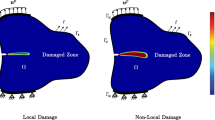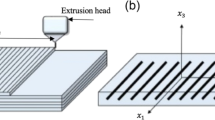Abstract
Incremental Sheet Forming (ISF) is a relatively new class of sheet forming processes that allow the manufacture of complex geometries based on computer-controlled forming tools in replacement (at least partially) of dedicated tooling. This paper studies the straining behaviour in the Single Point Incremental Forming (SPIF) variant (in which no dedicated tooling at all is required), both on experimental basis using Digital Image Correlation (DIC) and on numerical basis by the Finite Element (FE) method. The aim of the paper is to increase understanding of the deformation mechanisms inherent to SPIF, which is an important issue for the understanding of the high formability observed in this process and also for future strategies to improve the geometrical accuracy. Two distinct large-strain FE formulations, based on shell and first-order reduced integration brick elements, are used to model the sheet during the SPIF processing into the form of a truncated cone. The prediction of the surface strains on the outer surface of the cone is compared to experimentally obtained strains using the DIC technique. It is emphasised that the strain history as calculated from the DIC displacement field depends on the scale of the strain definition. On the modelling side, it is shown that the mesh density in the FE models plays a similar role on the surface strain predictions. A good qualitative agreement has been obtained for the surface strain components. One significant exception has however been found, which concerns the circumferential strain evolution directly under the forming tool. The qualitative discrepancy is explained through a mechanism of through-thickness shear in the experiment, which is not fully captured by the present FE modelling since it shows a bending-dominant accommodation mechanism. The effect of different material constitutive behaviours on strain prediction has also been investigated, the parameters of which were determined by inverse modelling using a specially designed sheet forming test. Isotropic and anisotropic yield criteria are considered, combined with either isotropic or kinematic hardening. The adopted constitutive law has only a limited influence on the surface strains. Finally, the experimental surface strain evolution is compared between two cones with different forming parameters. It is concluded that the way the plastic zone under the forming tool accommodates the moving tool (i.e. by through-thickness shear or rather by bending) depends on the process parameters. The identification of the most determining forming parameter that controls the relative importance of either mechanism is an interesting topic for future research.
















Similar content being viewed by others
Notes
The set named here “Mises-Swift” corresponds in [23] to “Set 1*”, “Hill-Swift” to “Set 1”, “Mises-AF” to “Set 5* Shell”, and “Hill-AF” to “Set 5 Shell”.
In the pie-tip of the brick pie-model, wedge-shaped elements (6 nodes) of 1st order and with reduced integration are used.
References
Jeswiet J, Micari F, Hirt G, Bramley A, Duflou J, Allwood J (2005) Asymmetric single point incremental forming of sheet metal. CIRP Ann—Manuf Technol 54(2):88–114
Emmens WC, van den Boogaard AH (2009) An overview of stabilizing deformation mechanisms in incremental sheet forming. J Mater Process Technol 209(8):3688–3695
Jackson K, Allwood J (2009) The mechanics of incremental sheet forming. J Mater Process Technol 209(3):1158–1174
Eyckens P, Del-lero Moreau J, Duflou J, Van Bael A, Van Houtte P (2009) MK Modelling of sheet formability in the incremental sheet forming process, taking into account through-thickness shear. Int J Mater Form (Proceedings of 12th ESAFORM conference) 2(Suppl.1):379–382
Emmens WC, Van den Boogaard AH (2007) Strain in shear, and material behaviour in incremental forming. Key Eng Mater 344:519–526
Sutton MA, Orteu J-J, Schreier HW (2009) Image correlation for shape, motion and deformation measurements: basic concepts, theory and applications. Springer Science+Business Media, LLC, New York
He S, Gu J, Sol H, Van Bael A, Van Houtte P, Tunckol Y, Duflou J (2007) Determination of strain in incremental sheet forming process. Key Eng Mater 344:503–510
Vasilakos I, Gu J, Belkassem B, Sol H, Verbert J, Duflou J (2009) Investigation of deformation phenomena in SPIF using an in-process DIC technique. Key Eng Mater 410–411:401–409
Henrard C, Bouffioux C, Duchêne L, Duflou J, Habraken AM (2007) Validation of a new finite element for incremental forming simulation using a dynamic explicit approach. Key Eng Mater 344:495–502
Hadoush A, van den Boogaard A (2009) Substructuring in the implicit simulation of single point incremental sheet forming. Int J Mater Form, Accepted for publication. doi:10.1007/s12289-12009-10402-12283
Ambrogio G, Filice L, Fratini L, Micari F (2004) Process mechanics analysis in single point incremental forming, Proc. NUMIFORM ’04. American Institute of Physics, Melville, pp 922–927
Bambach M, Hirt G, Junk S (2003) Modeling and experimental evaluation of the incremental CNC sheet metal forming process, Proceedings of the 7th International Conference on Computational Plasticity, CIMNE
Henrard C, Habraken AM, Szekeres A, Duflou J, He S, Van Bael A, Van Houtte P (2005) Comparison of FEM simulations for the incremental forming process. Advanced Materials Research (SheMet2005 conference proceedings) 6–8:533–540
Flores P, Duchêne L, Bouffioux C, Lelotte T, Henrard C, Pernin N, Van Bael A, He S, Duflou J, Habraken AM (2007) Model identification and FE simulations: effect of different yield loci and hardening laws in sheet forming. Int J Plast 23(3):420–449
He S, Van Bael A, Van Houtte P, Tunckol Y, Duflou J, Henrard C, Bouffioux C, Habraken AM (2005) Effect of FEM choices in the modelling of incremental forming of aluminium sheets. Proceedings of 8th ESAFORM conference 711–714
Eyckens P (2010) Formability in incremental sheet forming: generalization of the Marciniak-Kuczynski model, Katholieke Universiteit Leuven, PhD thesis. ISBN 978-94-6018-210-5
Bouffioux C, Henrard C, Eyckens P, Aerens R, Van Bael A, Sol H, Duflou J, Habraken AM (2008) Comparison of the tests chosen for material parameter identification to predict single point incremental forming forces. Proceedings of the IDDRG 2008 International Conference, pp 133–144
Eyckens P, He S, Van Bael A, Van Houtte P, Duflou J (2007) Forming limit predictions for the serrated strain paths in single point incremental sheet forming. Proceedings of NUMIFORM2007, American Institute of Physics, pp 141–146
Henrard C (2008) Numerical simulations of the single point incremental forming process, Université de Liège, PhD thesis
Li KP, Cescotto S, Habraken AM (1995) Numerical simulations and benchmarks of 3-d sheet metal forming using lagamine program, Numiform’95. Simulation of materials processing: theory, methods and applications, Balkema
Maguerre K (1935) Z Angew Math Mech 15:369–372
Habraken AM, Cescotto S (1998) Contact between deformable solids: the fully coupled approach. Math Comput Modell 28(4–5):153–169
Henrard C, Bouffioux C, Eyckens P, Sol H, Duflou J, Van Houtte P, Van Bael A, Habraken AM (2009) Forming forces in single point incremental forming, prediction by finite element simulations, validation and sensitivity, Submitted to Computational Mechanics
Vic 3D [http://Www.Limess.Com/Index.Php?Option=Com_Content&View=Article&Id=11%3avic-3d-&Catid=10%3avic-3d&Itemid=35&Lang=En], © Correlated Solutions Inc
Lecompte D, Smits A, Bossuyt S, Sol H, Vantomme J, Van Hemelrijck D, Habraken AM (2006) Quality assessment of speckle patterns for digital image correlation. Opt Lasers Eng 44(11):1132–1145
Acknowledgements
The authors from the Department of MTM at K.U.Leuven gratefully acknowledge the financial support from the Institute for the Promotion of Innovation by Science and Technology in Flanders (IWT) and from the Interuniversity Attraction Poles Program from the Belgian State through the Belgian Science Policy agency, contract IAP6/24. The authors from the department PMA at Katholieke Universiteit Leuven and MeMC at Vrije Universiteit Brussel gratefully acknowledge the financial support from the Institute for the Promotion of Innovation through Science and Technology in Flanders (IWT-Vlaanderen) and from the National Fund for Scientific Research, Belgium (F.W.O.). As research director, Anne Marie Habraken would like to thank the Fund for Research Scientific (FNRS, Belgium) for its support.
Author information
Authors and Affiliations
Corresponding author
Rights and permissions
About this article
Cite this article
Eyckens, P., Belkassem, B., Henrard, C. et al. Strain evolution in the single point incremental forming process: digital image correlation measurement and finite element prediction. Int J Mater Form 4, 55–71 (2011). https://doi.org/10.1007/s12289-010-0995-6
Received:
Accepted:
Published:
Issue Date:
DOI: https://doi.org/10.1007/s12289-010-0995-6




